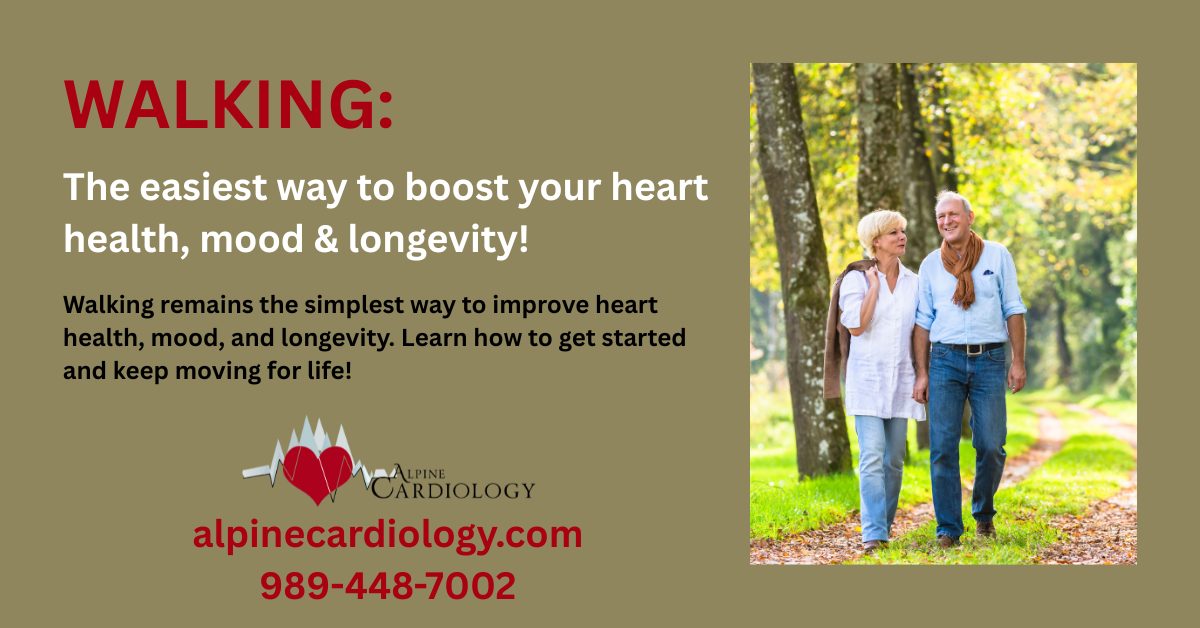When it comes to easy ways to stay healthy, walking continues to top the list. It’s simple, safe for most people, low-cost, and accessible. Plus, for such a basic activity, walking delivers impressive health benefits for your heart, body, and mind.
The Power of Walking
For every hour of brisk walking, some studies suggest life expectancy may increase by up to two hours. The U.S. Centers for Disease Control and Prevention (CDC) still recommends adults aim for at least 150 minutes of moderate-intensity activity, like brisk walking, each week. Even small amounts—just 10 minutes at a time—add up and can make a real difference.
Walking can help:
- Reduce your risk of heart disease, stroke, type 2 diabetes, and certain cancers.
- Lower blood pressure, improve blood sugar control, and boost HDL (“good”) cholesterol.
- Enhance mental well-being, reduce anxiety and depression, and sharpen memory.
- Strengthen bones, reducing the risk of osteoporosis and falls.
- Maintain a healthy weight and improve overall stamina.
Recent research even highlights walking’s role in reducing the risk of dementia and improving sleep quality—two increasingly important factors in healthy aging.
Walking vs. Running: Is One Better?
Walking remains the most popular physical activity in the U.S., according to the CDC. If running isn’t for you—whether due to preference, injury, or fitness level—walking is an excellent alternative. A well-known 2013 study showed that brisk walking can reduce risks of hypertension, high cholesterol, and diabetes as effectively as running, provided the same amount of energy is used.
How to Get Started with Fitness Walking
- Gear Up: Comfortable clothes and supportive shoes are all you need. Avoid cotton socks to prevent blisters.
- Start Slow: Begin with short, comfortable walks of 10–15 minutes and gradually build up.
- Focus on Form: Keep your head up, shoulders relaxed, and arms swinging naturally.
- Breathe: If you’re too winded to talk, slow down. Consistency matters more than speed at first.
- Pick Up the Pace: Warm up slowly, then aim for a brisk pace that slightly raises your heart rate.
- Add Variety: Try intervals, hills, or different routes to keep things interesting and challenge your body.
- Stretch: End your walk with gentle stretches for your legs, back, and shoulders.
- Track Progress: Apps, step counters, or simply noting your time can help you stay motivated.
Walking Safety Tips
- Be Visible: Wear bright or reflective clothing, especially in low light.
- Stay Alert: Keep music low, avoid texting, and be aware of your surroundings.
- Choose Safe Routes: Stick to well-lit, populated areas and sidewalks when possible.
- Walk with Others: A buddy, group, or dog makes walking safer and more enjoyable.
Listen to Your Body
If you experience joint pain, numbness, or unusual fatigue while walking, consult your healthcare provider. There are many ways to stay active—cycling, swimming, or even chair exercises—if walking isn’t right for you.
Simple Ways to Add More Steps:
- Take the dog for an extra stroll.
- Walk with a friend instead of sitting for coffee.
- Park farther from entrances.
- Take the stairs when possible.
- Walk while talking on the phone.
Bottom Line: Just Start Moving
Whether you’re new to exercise or looking to boost your routine, walking remains one of the easiest and most effective ways to improve your physical and mental well-being. Remember: it’s not about perfection—it’s about progress. Every step counts!
Dr. Bobish
Dr. Bobish and her team’s goal is to help you reduce your risk of heart disease. Helping you to understand your risk factors and make healthful lifestyle changes.
Remember regardless of age or current state of health it is never too late to start protecting your heart. It is also never too soon and the sooner you act the better. Follow us on Facebook to see our latest post helping to keep you heart healthy. You can also explore all our articles that offer diet and exercise tips, recipes and information on procedures and heart disease.
Dr. Bobish and her team focus on preventative care and are here to support you. Alpine Cardiology provides patients with education as well as compassionate care and treatment. We are committed to keeping you healthy and heart smart! Request an appointment at 989-448-7002

